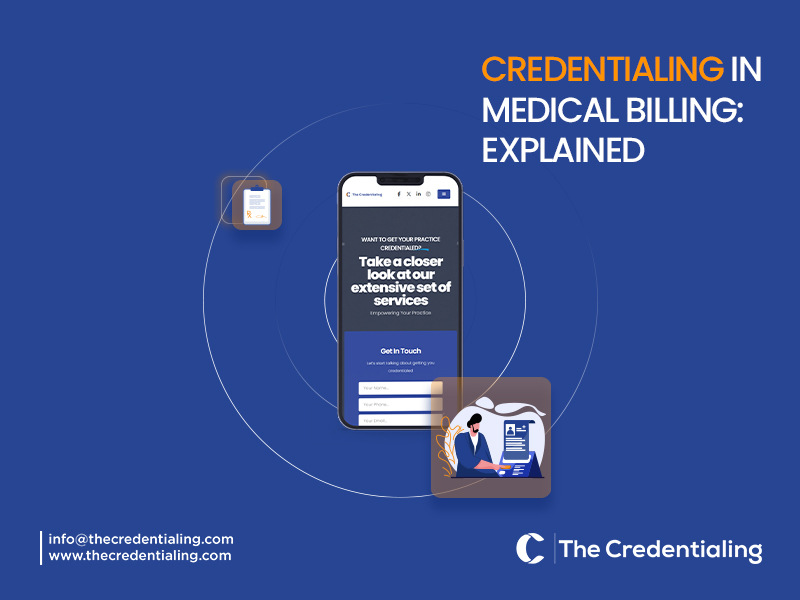Credentialing in Medical Billing: Explained
Medical credentialing is the process of checking and confirming a healthcare provider's
qualifications, licenses, and professional background. In terms of medical billing, this
thorough review is mandatory as it ensures that a medical professional meets the
academic and professional criteria set for healthcare providers. Only after this
validation by regulatory agencies, insurance companies, and healthcare organizations is
a provider allowed to render services to patients.
In the ever-evolving healthcare system, medical credentialing has become extremely
important. It helps maintain the integrity of healthcare, ensures patient safety, and
builds trust among patients and healthcare providers. However, recently, it has been
observed that the process has become too complicated, resulting in common errors. In
this blog, we will explain Credentialing in Medical Billing in detail.
Types of Credentialing
The main types of Credentialing are as follows:
Initial Credentialing: Ensuring Qualified New Hires
Initial credentialing is performed to provide patients with a qualified healthcare provider. It is a detailed procedure meant to verify the qualifications and background of newly recruited healthcare professionals before they are formally allowed to practice. The following are integral components of initial credentialing
- Education Verification
- License Verification
- Work History Verification
- Professional Reference Checks
- Background Checks
- Skills Assessments
Re-credentialing: Maintaining Standards for Continued Practice
Re-credentialing is an ongoing process that ensures healthcare professionals maintain the necessary skills and knowledge to continue practicing safely and effectively. It typically occurs periodically, with the frequency varying depending on the profession and licensing board requirements. Here's a breakdown of what re-credentialing often involves:
- Continuing Education (CE) Verification
- License Renewal
- Performance Reviews
- Professional Development Activities
Steps of Credentialing
The credentialing process typically involves several key steps to ensure that healthcare providers meet the necessary standards for delivering care. Here are the main steps of credentialing:
- A detailed application that must include personal, professional, and educational information should be submitted by the provider.
- The submitted information will be verified by the regulatory body or insurance company (to whom it is submitted). They may verify it from original or primary sources.
- Next, the payor runs a complete background check on the provider's professional history. The provider's record is checked for any malpractice claims, disciplinary actions, or criminal records.
- The provider’s work history, including previous employment, privileges at other healthcare facilities, and clinical performance, is reviewed.
- The credentialing organization may also contact references such as previous employers, colleagues, or mentors to gather firsthand information about the provider.
- A committee of senior healthcare professionals reviews all this collected information and makes recommendations regarding the provider’s competence.
- In light of the recommendations made by the honorable committee, a decision is made to approve, deny, or request additional information
- The healthcare provider is informed of the decision. If approved, they receive details about their scope of practice and any conditions or limitations.
- Credentialing is an ongoing process. Providers are periodically re-evaluated, typically every two to three years, to ensure they continue to meet the required standards.
Tips for Successful and Timely Provider Credentialing
Start Early and Stay Organized:
Begin the credentialing process well in advance of the provider’s start date. This allows ample time for collecting all necessary documents, completing applications, and addressing any issues that may arise. Maintain a checklist of required documents and deadlines. Keep all records and correspondence organized for easy access and follow-up.
Thorough and Accurate Documentation:
Ensure all information provided in the application is complete and accurate. Inaccurate or missing information can cause delays and complications. Double-check that all supporting documents, such as licenses, certifications, and work history, are up-to-date and properly authenticated.
Regular Follow-Up and Communication
Stay in regular contact with the credentialing authorities and follow up on the application's status. Proactive communication can help identify and resolve any issues quickly. Keep the provider informed of any progress or additional requirements to ensure they are prepared to respond promptly.
Trust TheCredentialing to get yourself Credentialed with Top Payors
Feeling overwhelmed by the paperwork involved in getting credentialed or having a headache navigating the unique demands of insurance companies? There is no need to worry. TheCredentialing simplifies the tedious task of credentialing by introducing its online portal. Now, you can access your credentialing information and view application status from anywhere. All you need to do is simply log in to your account. Document sharing has also been made effortless by introducing a dedicated FTP ( File Transfer Protocol). We also ensure robust security measures to ensure the safety of your vital information. Last but not least, you can also make payments by simply filling in your banking details.
